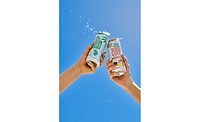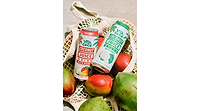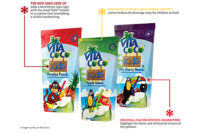Vita Coco works to make coconut water the next orange juice
Coconut water brand uses flavors to appeal to consumers





As a result of positive feedback and sales of its Vita Coco Kids lineup, the company introduced two new limited-edition flavors timed with the April 2014 release of the “Rio 2” movie, Jane Prior says. (Image courtesy of Vita Coco)





Ten years ago, U.S. consumers might have thought you were a bit “nutty” if you told them that coconut water would be a multimillion-dollar beverage category one day. In fact, Vita Coco Co-founders Michael Kirban and Ira Liran didn’t even believe it at that time. When the entrepreneurs decided to start up All Market Inc., doing business as Vita Coco, they simply thought it would be a fun hobby that would earn them some extra money, Liran notes.
| Jump to: |
“We never had these grandiose expectations,” he says. “… We knew that it was an excellent product that had great potential, but I think our feet were grounded, and we just thought it would be like a little hobby [and] a way to make a little extra pocket change. We never imagined that it would become this, what it is today.”
Last year, the company experienced triple-digit growth, reaching an estimated $250 million in revenue worldwide, the executives note. And despite competition from big players such as Atlanta-based The Coca-Cola Co. and Purchase, N.Y.-based PepsiCo Inc., Vita Coco maintains approximately 69 percent share of the premium coconut water market, they add, citing recent Nielsen data. In fact, the company currently cracks 1.5 million coconuts a day in order to meet demand in the United States and about a dozen other countries, Kirban says.
To boot, the brand is pulling sales from other beverage categories as well, with the potential of becoming the next orange juice, he adds.
“In Brazil, coconut water is the highest consumed packaged juice, way outperforming orange juice,” Kirban notes. “We’re a long way away from that, but if you look at the beauty of this category, we’re pulling from bottled water, we’re pulling from enhanced water …, we’re pulling from sports drinks …, we’re pulling from juice like orange juice and cranberry juice and grape juice, and all these other things.”
Thanks to Vita Coco’s broad appeal, Kirban anticipates major growth for the brand in both the United States and international markets in 2014. Moreover, he expects the entire category to outperform grape juice sales and catch up to cranberry juice sales this year.
Structured for growth
The company is able to tackle such significant growth because of its unique investments in the supply chain, among other factors. In order to manufacture coconut water on a scale that was never attempted before, Kirban and Liran realized early on that they would need to build their own infrastructure from scratch. Therefore, in 2008, the company entered into a joint venture and invested approximately $2 million in a factory in Brazil, despite the fact that Vita Coco was only making between $2.5 and $3 million in revenue, Kirban notes. Today, the company has financial investments in 11 production facilities in Brazil, Southeast Asia,
the Philippines and Mexico.
These investments offer the company scalability, which has proven to be critical as Vita Coco has progressed. The facilities have gone from producing 250,000 liters in 2008 to 20 million liters a year as of 2013, Liran notes. The company’s current supply footprint offers the possibility to build a $1.6-$1.8 billion business, Kirban adds.
This facility flexibility likely will benefit the company as Vita Coco’s popularity continues to rise overseas. Currently, Vita Coco’s largest market is New York, which is where the company was built and is headquartered. However, London will overtake the city as the No. 1 market for Vita Coco within the next six months, Kirban says. The brand also is experiencing significant sales in Paris, Amsterdam and Japan, he notes.
“[For] some of the key [international retail chain] accounts that we’re in, our volume per store is better than almost any chain in the U.S.,” Kirban says. “So as we expand distribution in these countries, we’re seeing multiple triple-digit growth annually for the next couple of years.”
Kirban attributes this success partially to the company’s inter-national strategy as well as the amount of shelf space that is available in these markets.
“What we’re doing differently than a lot of U.S. brands that start to expand globally is we’re not just giving licenses; we’re not just giving the brand to local distributors,” he says. “We’re building teams in every market, and we’re replicating what we did in the U.S. in every single market.”
Additionally, the beverage industries in these European and Southeast Asian markets are not as developed as in the United States, which means beverage-makers don’t need to battle for shelf space as much, Kirban adds. As a result, Vita Coco can leverage its strength in winning shelf and display space in the U.S. market in order to quickly drive brand awareness overseas, he explains.
The company also plans to launch Vita Coco in some new developing markets in which coconut water already has an established awareness and presence. This will offer consumers a consistent, quality coconut water with an American twist, the executives say.
On the contrary, only about 40 percent of consumers in Vita Coco’s top U.S. markets of New York, Chicago, Los Angeles and Boston have even heard of coconut water, let alone tried it, Kirban says. Familiarity with coconut water is even lower in the Midwest, with 4-6 percent of consumers knowing what coconut water is, he adds. However, multiple efforts are helping to bring the category — as well as the Vita Coco brand — mainstream in the United States.
Gaining mainstream appeal
In the beginning, Hispanic, Southeast Asian and Indian consumers who already were familiar with coconut water provided early adoption for the Vita Coco brand in the United States, Kirban says. “Unlike any other beverage I can think of that has created a category over the last 20 or 30 years, we had this built-in demographic that was buying and drinking the product,” he says.
Plus, when the brand earned national distri-bution with Whole Foods Market in 2007, it was able to capitalize on the emerging wave of “health nuts,” so to speak.
“So we had the ethnic consumer and the super early adopter health-[conscious] consumer, and then what we had to do over the last 10 years is bridge the gap in between the two of them to the mainstream American consumer,” Kirban notes.
Enter Vita Coco coconut water with fruit purees.
“The flavors were a way to facilitate people’s entry into the coconut water category,” Liran says. “[Pure coconut water] is an acquired taste to some, but the flavors helped make that ease of transition to mainstream.”
In fact, Liran notes that consumer testing revealed that even if consumers didn’t enjoy the taste of Vita Coco Pure, 99 percent of them enjoyed Vita Coco Pineapple.
Furthermore, celebrity investors, including Madonna, Matthew McConaughey and Demi Moore, have not only boosted brand and category awareness, but they’ve also given credibility to the brand. And when the company developed a partnership with Plano, Texas-based Dr Pepper Snapple Group (DPS) as a distributor in 2010, the brand’s national footprint got even more of a boost.
“[DPS was] a big part of building our national footprint, so we can now go to national accounts, really be in every store within planograms in large national retailers like Kroger and Safeway,” Kirban says. “They’ve been a big part of our expansion over the last four years.”
As coconut water continues to get more mainstream, Vita Coco is leveraging its brand equity to reach other consumer groups and drinking occasions in other categories.
Lemonade upgrade
This year, in parallel with its 10th anniversary, the company released Vita Coco Lemonade.
“The purpose of this Lemonade introduction was really to leverage the history and the equity of lemonade and bring that over into the coconut water category and use that as a catalyst to bring new consumers into the category,” says Jane Prior, vice president of U.S. marketing.
Even though the product has only been on store shelves for approximately two months, it’s already exceeding the company’s projections. Kirban notes that the company has sold double or even triple the forecasted volume for the SKU. As a result, it dedicated an entire facility to Vita Coco Lemonade production in order to meet demand, he says.
In addition to bringing new consumers into the coconut water category, the lemonade-coconut water blend opens up a new drinking occasion for the brand, notes Jeff Rubenstein, senior vice president of global strategy. With a thicker viscosity, Vita Coco’s flavored coconut waters typically act as juice alternatives for the morning consumption occasion, he notes. However, Vita Coco Lemonade is a thinner liquid, which gives it the “gulpability” needed for afternoon consumption during the summer months, he explains.
“The purpose of this Lemonade introduction was really to leverage the history and the equity of lemonade and bring that over into the coconut water category and use that as a catalyst to bring new consumers into the category." |
Additionally, the graphic design of the Vita Coco Lemonade packaging opens up an opportunity for a new subcategory, Rubenstein says.
“If you think about the way that our base brand is set up, the little hanging wood plank there gives us a secondary platform, so if we decide we want to introduce other secondary platforms that make sense for summer or that have this other sort of theme, we can do that now with just a simple wood dropdown,” he says. Although the company can’t discuss any new product introductions just yet, consumers might see this secondary platform come to fruition in the summer of 2015, he hints.
This summer, Vita Coco is putting a focus on its new Lemonade SKU through a “lemonade upgrade” marketing campaign. Vita Coco also expects to launch a personality-driven campaign this summer.
Joining the family
This year, Vita Coco also leveraged its brand equity by renaming and repackaging its recently acquired Coco Cafe brand as Vita Coco Cafe. The company originally acquired a majority share of Coco Cafe in 2012.
“It was a product that we loved, we tasted, and we saw a market potential for something really different and unique,” Kirban says. “The idea was, we could probably do it ourselves, but these guys have created a great product, the taste was great, the look and feel was great, [so] we felt it just made more sense to make an acquisition and roll them into our business and work together as a team to build that brand.”
Although the brand comes from a small base, it has grown hundreds of percent each year, Kirban notes. Vita Coco just began pushing the brand out nationally last year, he adds.
The new packaging for Vita Coco Cafe espresso and coconut water drinks feature similar color profiles to the previous cartons but with Vita Coco branding. The rebranded beverages began hitting retail shelves last month.
Bringing the brand under the Vita Coco name also has helped simplify the company’s marketing and merchandising efforts, Rubenstein and Prior note.
“In the past, we tried to build two separate brands: the [Coco] Cafe brand and the base Vita Coco brand,” Rubenstein explains. “Now you have one brand, two extensions. It’s much more simplified. You can tell one story about the performance to one category manager … and you can introduce Cafe as that secondary multiple functional benefit offering, and you don’t have to go pitch [to] two separate people.”
The rebranding also simplifies the consumer’s understanding of the product, Prior adds.
“From a marketing perspective, we can integrate Cafe now seamlessly into all of our other efforts, and there’s no confusion for the consumer, and we benefit from all the equity that we’ve built from the base brand and just sort of transfer that over to Cafe,” she says.
While Vita Coco Cafe cracks into the ready-to-drink coffee category, last year’s launch of Vita Coco Kids enabled the company to break into the children’s drink market. Prior notes that Vita Coco Kids has experienced steady growth since it entered the market last summer.
Available in Apple Island, Paradise Punch and Very Cherry Beach flavors, Vita Coco Kids drinks were created to offer a healthful, functional, low-sugar beverage for children, Prior says. The company conducted significant consumer research, resulting in beverages with 50 percent coconut water, natural ingredients, and flavors that kids would enjoy that also maintained the fun and integrity of the Vita Coco base brand, she explains.
As a result of positive feedback and sales, the company introduced two new limited-edition flavors timed with the April 2014 release of the “Rio 2” movie, she notes. Gabi’s Pink Lemonade is named after new “Rio 2” character Gabi, voiced by Kristin Chenoweth, and Blu-Berry Beach features the main character, Blu, a blue macaw voiced by Jesse Eisenberg. Gabi’s Pink Lemonade is available exclusively at Target, while Blu-Berry Beach is available in multi-outlets, including Target stores, she notes.
In August, Vita Coco will introduce a new product exclusively at Target as part of the retailer’s “Made to Matter” program, which brings together 17 natural, organic and/or sustainable brands to introduce new products and make them more accessible, according to the retailer. Although the product cannot be unveiled just yet, it looks like the sky is the limit when it comes to innovation for Vita Coco.
“When we look at innovation today, we’re not looking just at this coconut water set that we’ve helped to create,” Kirban says. “We’re looking at the entire grocery store.”
Finding a home on-shelf
Regardless of the product line, all of Vita Coco’s beverages complement the macrotrends toward health and wellness as well as functionality, Prior and Rubenstein note. These dual-benefit drinks, such as Vita Coco Cafe’s delivery of energy and hydration, are where the industry is headed, Rubenstein adds.
But when a product’s formulation and functionalities cause it to overlap multiple beverage categories, how do you merchandise it at retail? According to Prior and Rubenstein, it all comes down to finding adjacencies and creating points of interruption. For instance, Vita Coco Cafe doesn’t typically sit with the base Vita Coco line on the shelf; it sits in the ready-to-drink coffee aisle, Rubenstein says. Likewise, Vita Coco Kids is typically found in the kids’ drink aisle, he adds.
Additionally, approximately 20 percent of Vita Coco’s business comes from creative off-shelf displays, Rubenstein says.
“Being off-shelf is critically important, because as a brand that only has 4 feet or, if we’re lucky, 6 feet of space on the retail shelf, we need to be off the shelf for you to discover it and sort of bump into it in the store,” he explains. Therefore, the company brings the tropical feel of Brazil with coconuts, beach balls, fake sand, lawn chairs and more directly to retail stores in the form of creative displays.
The brand also connects with consumers in the produce section of some retail stores, Prior points out. By placing Vita Coco in hanging racks attached to beverage coolers or directly onto fruit racks, such as banana racks, the brand can capitalize on shoppers who are seeking potassium found in bananas, for instance, she notes. If shoppers aren’t going into the store with coconut water on their shopping lists, it’s important for the brand to interrupt them, she emphasizes.
Regardless of where shoppers find the product at retail, it’s critical to get the product in the hands of consumers and get them to taste it in order to win them over, the team says. Therefore, field marketing remains a top priority for the company.
“People like to connect to the brand and the celebrities and the PR or marketing that we’ve gotten over the years, but until you actually feel the functionality of the product when you’re in need of hydration, it’s at that moment that people really connect to the brand or the category,” Kirban says.
Like Kirban and Liran, the hope is that consumers might also become a little “nutty” for coconut water once they’ve tried it.
- Technically, the Bahamas was the first market in which Vita Coco was sold. After producing three shipping containers of coconut water for the U.S. market, Vita Coco Co-founders Michael Kirban and Ira Liran learned that they did not have proper U.S. Food and Drug Administration registration. As the result of a learning curve, the entrepreneurs instead shipped the product to the Bahamas and began distribution there until their registration was approved in the United States a few months later.
- Vita Coco utilizes every piece of the coconuts it processes. In addition to the water, this includes the meat, oil and shell, which can be used for animal feed, carbon fiber and pasteurization, Kirban notes.
- Kirban and Liran met the founders of Coco Cafe in late 2011 and closed the acquisition just a few months later, in February 2012, according to Jose Carvalho, Vita Coco chief financial officer.
- Vita Coco Pure is the company’s bestseller, accounting for approximately 50 percent of the business, Kirban says.
- Singer Rihanna was the brand’s first celebrity spokesperson and was featured in a national advertising campaign in 2011 and 2012.
- Vita Coco’s ownership is divided between majority shareholders Kirban, Liran and Belgian investment firm Verlinvest, with approximately 10 percent owned by celebrity investors and another approximately 10 percent owned by employees and other smaller investors.
Looking for a reprint of this article?
From high-res PDFs to custom plaques, order your copy today!











